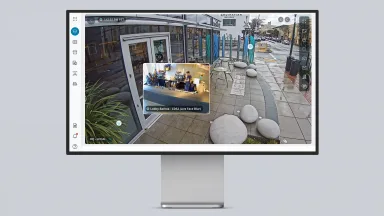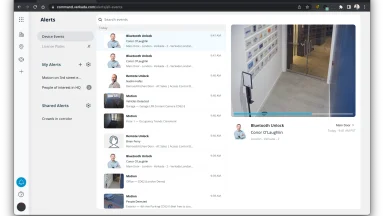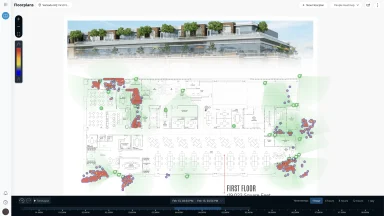A door is more than a threshold. It's the moment of truth for organizational security. Recent attacks at corporate campuses, schools and other organizations expose a troubling pattern: devastating security breaches often trace back to compromised entry points.
The Bureau of Labor Statistics recorded 740 fatal workplace incidents from violent acts in 2023 (the most recent year for which data is available), and each one a stark reminder that theoretical threats can become tragic realities in seconds. But focusing on statistics misses the deeper truth that every organization has unique vulnerabilities that demand customized solutions. The key isn't just fortifying entrances, but reimagining how we approach access control in an age where threats evolve faster than our defenses.

Growing Threats at the Doorstep
Security failures are not just about inconvenience or minor risks—they can have real, devastating consequences. Workplace violence is an escalating issue, with businesses increasingly targeted by individuals harboring grievances. The tragic December 2024 shooting of UnitedHealthcare CEO Brian Thompson is a stark reminder of this reality. Thompson was fatally shot on the streets of New York City, sending shockwaves through the health insurance industry and raising alarms about workplace safety. In the wake of his killing, health insurance companies have increased security measures, as fear and uncertainty grip employees across the sector.
Per the New York Times, the attack left many employees deeply unsettled, with one UnitedHealthcare worker expressing a growing sense of fear: “Lots of us were feeling like we were horrible because we’re being accused of working for the evil empire... but we all do the best we can to do a good job in the system we are in.” The employee, like many others, spoke anonymously due to concerns for her own safety.
Even before Thompson’s murder, tensions in the industry had been rising. The mayor of Minnetonka, MN, where UnitedHealthcare is headquartered, acknowledged the climate of fear, stating, “Clearly the employees have been shaken… we are going to do everything we can to keep them safe.”
The threat of workplace violence is not exclusive to the corporate sector. Within days of the UnitedHealthcare incident, a former employee of the Cleveland, OH VA hospital was arrested for threatening to shoot three of her colleagues after being fired, warning them that she could carry out the shooting "at any time." Her threats were taken seriously, especially after witnesses confirmed that she had previously spoken about owning a gun.
Beyond verbal threats, the terminated employee’s behavior raised further red flags, as she was seen driving around the hospital after making her threats—and was even reported to have followed her former supervisor in her car on multiple occasions. This case underscores how quickly a terminated employee can turn into an active security threat.

A case from Corpus Christi, TX further illustrates the dangers posed by disgruntled former employees. In November 2024, a 35-year-old former worker repeatedly returned to his old workplace to harass and threaten his former colleagues. Employees reported him to the police multiple times, but he fled before officers could arrive. Later that day, he escalated his aggression, attacking a co-worker in the parking lot, which led to another employee stabbing him in self-defense.
Meanwhile, schools remain a vulnerable target for intrusions by dangerous individuals. In 2022 in Riverside, California, a registered sex offender hopped a fence into McAuliffe Elementary School and entered a girls’ bathroom before being apprehended. A campus supervisor witnessed the man leaving the restroom while hearing a young girl crying inside. The suspect fled, but thanks to a witness providing a vehicle description, authorities were able to track him down and arrest him later that day.
The emotional toll on students and families was profound. “He said that all he could hear was teachers saying, ‘Run, hurry, faster, run, run, run,’” one parent recalled about her son’s experience during the incident. “That’s what played through his mind the whole weekend.” Another parent questioned, “If this is the first time this guy got caught, how many times has this happened? How many times has he done this, you know what I mean? Waiting in bathrooms for kids to come in?”.
Why Current Security Measures Are Failing
Many organizations struggle to balance security with convenience. Employees, students, visitors, and vendors expect a seamless experience when entering a building, and security measures that feel overly restrictive can create friction or increase the expectation of violence. However, as seen in recent attacks, failing to implement proper security can have far more devastating consequences than a slight inconvenience.
One of the biggest issues is delayed law enforcement response. Security teams often rely on police intervention when a situation turns dangerous, but by the time authorities arrive, the damage may already be done. In the days immediately after the attack, the Minnetonka police department were on the case of new incidents involving the UHC campus, including one in which they had to ask a journalist to leave the property and a more serious one involving “vague threats in the past” by a former employee. This underscores how unpredictable workplace violence can be, making proactive security even more critical.
Similarly, in the Riverside school incident, the perpetrator had already entered the school, accessed a restricted area, and fled before police could arrive. Even though law enforcement successfully arrested the suspect, the fact that he gained entry in the first place is alarming. “Children should never experience a situation such as this,” said Alvord Unified School District Superintendent Allan Mucerino, adding that even when schools follow security best practices, threats persist.

Another challenge is the complexity of managing security across multiple locations. Large enterprises, schools, and healthcare facilities often operate across several sites, making it difficult to enforce a standardized approach to access control. Without a centralized system, inconsistencies in security protocols can leave some locations vulnerable.
Standard security measures fail because they're designed for yesterday's threats. Entryway security isn't just about having “a system” but about having one that can adapt as quickly as the risks evolve. Modern entryway security solutions enable a more dynamic defense: video security systems that can flag persons of interest the moment they step onto campus with AI-powered analytics, automated screening against sex offender registries at check in, high quality, low latency video and audio intercoms, and real-time video sharing with law enforcement during emergencies to help prioritize threat assessments and responses.
Design for Defense
Security failures cascade. A compromised entry point ripples through an organization, creating vulnerabilities that multiply with each passing moment. But focusing purely on defense creates its own blindspots.
The most effective security strategies work like a conversation—they respond and adapt, helping to identify threats at the point of entry while maintaining the delicate balance between protection and accessibility. As those threats become less predictable, the strongest shield is one that thinks ahead.
The time for reactive security ended with yesterday's threats. Tomorrow's safety depends on what we do at the door today.





